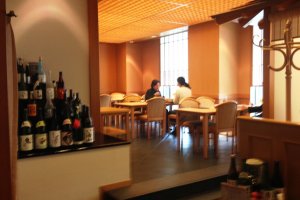The darkest parts of the night are the moments just before dawn. The folk in Hokkaido, with their long, often harsh winters, understand this very well. Being in tune with the nature’s heartbeat is part of life here. Just as you cannot hurry the dawn of the day, you can’t hurry the long winter, or the harvest of the fruits of nature. So when the asparagus harvest happens in May, you can’t help but celebrate its bounty and the gifts that no man can create. It may take its time to bring food from the farm to your table, but this is nature’s way of celebrating life, one where every day of growth is part of the nature’s timing.
Sekka, which means snow flower, is Emisia Sapporo Hotel’s showcase Japanese restaurant at Shin Sapporo. Dining here is like being transported to the cobbled stoned geisha lanes of Kyoto’s Pontocho district. The wabi-sabi style natural wood decors, the sushi counter and the Kyoto trained chef is all part of the refined experience. What’s more, the ceiling to floor windows and the city fringe location gives the place an airy and relaxed feeling away from the busy lunchtime crowds.
Be sure to try the Komachi-Gozen, from their set lunch menu. This is no ordinary bento that you find in the supermarkets, train stations or food halls, as delicious as they are. The exquisite artisan serving boxes and porcelain saucers and bowls are colorful as well as timeless. Some of the bowls look like half lemons with citrus like dimples on the outside, but with white and blue patterns on the inside to complement the preserved vegetables, pickles and other Japanese delicacies. Here you enjoy the food first with your eyes, and then slowly savor every bite.
Natsuki san from the hotel tells me that every month in Hokkaido is associated with the harvest of a particular vegetable or seafood. For example January and February is for codfish and king crabs, while May and June is for Asparagus, sea urchin and scallops. When even the marketing and administrative managers here go fruit and vegetable picking on the weekend, you know they are in tune with the best seasonal produce.
The lime green tofu has its color from the green beans used to make it. It is similar to the zunda mochi which is the pride of Sendai. It has a texture that reminds me of bread, or more specifically, bread and butter pudding. Part of the adventure of eating here is challenging the perceptions of what certain foods should taste like. Tofu is not usually associated with fresh bread, but having freshly made tofu with its nutty and almost creamy flavor is a far cry from the bland flavors that you would normally associate with tofu.
Since the days of the Tale of Genji, part of the fun of experiencing Kyoto cuisine is trying to guess what lies inside those immaculately presented meals. The alluring yellow ball could be a lemon peel dessert or a savory dish, but you don’t know until you take it in, with its almost melt in the mouth texture and the mild flavor of mince hidden behind the covering of mashed lotus root. On the other hand, the tender winter melon slices were easier to guess, being a comfort food that is said to lower your internal heat and blood pressure, it is nature’s way of preparing your body and mind for summer. The local Hotate scallops were also easy to spot in its shell, being juicy and well balanced with the freshly harvested asparagus.
The head chef, Yokoyama san, loved cooking since he was a child. Born to a family that owned a restaurant, he grew up with the aroma and the excitement around the family kitchen, and picked up the tools of the trade with relish. He would spend hours seeing how it consumed his family, the nurture and care in the way they treated the ingredients, as well as the traditional Japanese ceramics that his father used when guests came for a meal.
At the same time he wanted to reach the pinnacle of Japanese cuisine, so he moved to Kyoto to train as a chef for five years, learning from the masters at a traditional Japanese restaurant. His country roots were never far away, however, and returning home gave him the opportunity to serve the best Hokkaido ingredients in season, served in the traditional Kaiseki manner that has been refined over the centuries. Since the addition of Japanese cuisine to the UNESCO intangible heritage list in 2013, the number of foreign guests has increased day by day. Spring is a good time to visit, not only for the scallops and asparagus, but for the cherry blossoms as well in the second week of May.
If you are visiting Hokkaido, drop in to Sekka and experience nature’s harvest, and take a piece of Kyoto with you.
































